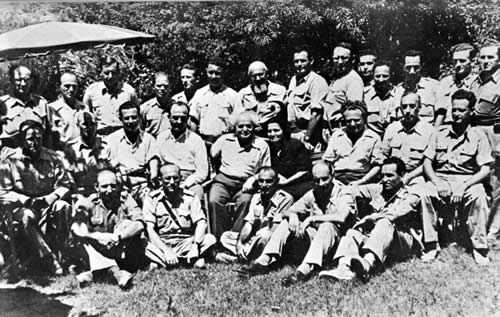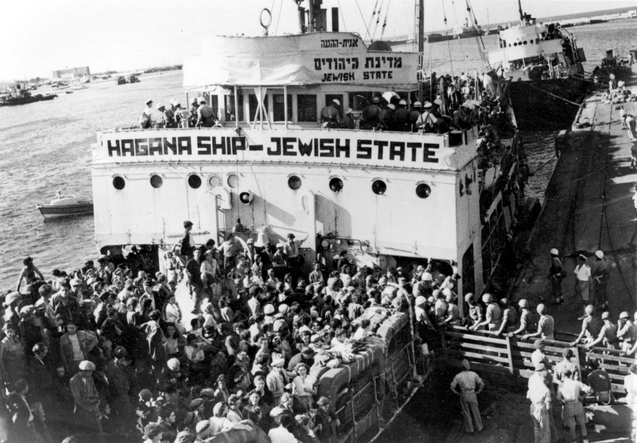 |
| Haganah command |
The Haganah (Hebrew for "defense") was an underground Jewish paramilitary organization created during the British mandate in Palestine in 1920. The Haganah began as a small voluntary body of men called Ha Shomer, formed to guard Jewish settlements, or kibbutzim.
The Haganah consisted of soldiers who had fought for the British in World War I as well as local farmers who were determined to defend their property from Arab attacks. After the Arab riots of 1920 and 1921, when Jews and their property fell under attack, the Jewish population realized that the British administrators would do nothing to guarantee their safety and that they had to learn to defend themselves.
At this time, the Haganah was poorly armed and not well coordinated. Its duties mainly consisted of guarding the borders between Arab and Jewish populations. In the Arab-Jewish clashes of 1929, the Haganah improved as a defense organization by securing their three main sectors in Jerusalem, Tel-Aviv, and Haifa as well as in other settlements of Palestine.
  |
The Haganah became a countrywide organization including men and women of all ages from both kibbutzim and the cities. Training programs as well as officers' training began, while a steady stream of weapons started to arrive from Europe. The underground production of weapons also began.
During the Arab revolt in 1936–39, the Haganah matured and developed from a militia into a military body to successfully defend Jewish quarters and settlements from Arab attack. The British did not officially recognize the Haganah, but in the midst of the uprising they did help to organize several special forces groups trained in different tactics to help defend British interests.
In April 1937, a revisionist splinter group of the Haganah known as Irgun Zvai Leumi, or simply Irgun, began its own operations. Irgun's policies differed from those of the Haganah in that Irgun targeted the British as well as Arab Palestinians. The British 1939 White Paper, restricting Jewish immigration into Palestine, added to Jewish anger toward the British.
 |
| Haifa, Mandatory Palestine, The Jewish State, a Haganah ship captured by the British |
The White Paper was viewed by Zionist leaders as a betrayal of British intentions stated in the Balfour Declaration of 1917. As a result, the Haganah began helping to guard illegal immigrant ships as they arrived along the Palestinian coast. In the process, many illegal Jewish immigrants died due to drowning and overcrowding on the tiny ships and also ended up in Nazi camps after being turned away by the British upon arrival.
In June 1940, a splinter group of the Irgun left the organization after a disagreement on the decision to suspend its armed campaign against the British during World War II. These members established a more radical group called Lehi, also known as the Stern Gang, named after its new leader.
The Haganah itself was evolving into a national and relatively nonpartisan clandestine Jewish army. At this time it wished to distance itself from the Irgun's and Lehi's methods. The Haganah was officially an illegal organization, too, and yet at the same time the British cooperated with it during the Arab revolt (1936–39) and yet again during World War II.
In 1941, select members of the Haganah under British training became an elite command force, the Palmah, which was created to counter an anticipated Nazi takeover of Vichy-held Lebanon and Syria. At the conclusion of World War II, it became apparent that Britain would not change its policies in Palestine, nor would it allow a mass Jewish migration into the region. The Haganah then decided to join in on the actions of the Irgun and Lehi by attacking the British in commando raids and sabotage attacks.
The Haganah membership consisted of illegal immigrants as well as over 26,000 Palestinian Jews who had served with the British in World War II. Some of the strengths of the Haganah included its bravery, its initiative, and its ability to improvise during battle. It developed an impressive military intelligence system that allowed it to spy on the British and the Palestinian Arabs.
It also became very skilled in covert operation tactics such as stealing weapons from the British and hiding the many immigrants it helped smuggle into the region. Training activities and the purchase of weapons abroad were stepped up after the 1947 UN partition plan, which called for the partition of Palestine between the Palestinian Arabs and the Jews.
Shortly after this, the Haganah, along with Irgun and Lehi, began concerted attacks on Palestinian Arabs in an attempt to force them out of the Jewish areas that were outlined in the UN plan. Some 300,000 Palestinian Arabs were displaced from their homes in five weeks, including an all-day attack on Deir Yasin village resulting in the deaths of over 250 men, women, and children.
 |
| Haganah in the 1948 Arab-Israeli War |
Days after the British mandate ended, Israel was declared an independent state, and in the 1948 Arab-Israeli War, also known as the War of Independence, Israel held on to the territory that had been allotted to it in the partition plan and also extended its territory by approximately one-third.
At the time of the Israeli declaration of independence, the new government, led by David Ben-Gurion, decided that the new state would not have any armed militias or partisan groups, and the Haganah dissolved into the Israeli Defense Force, or IDF.